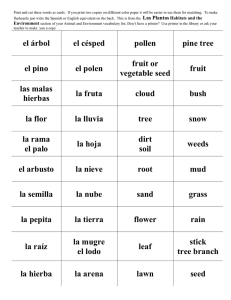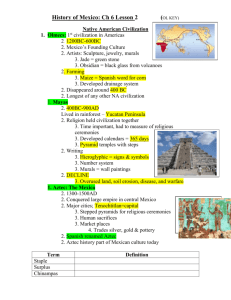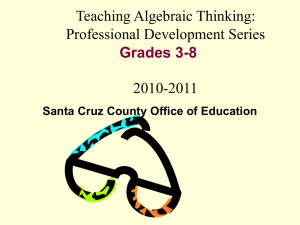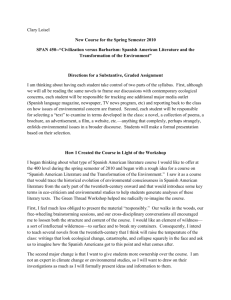Lesson Plan: Pepita Talks Twice
advertisement
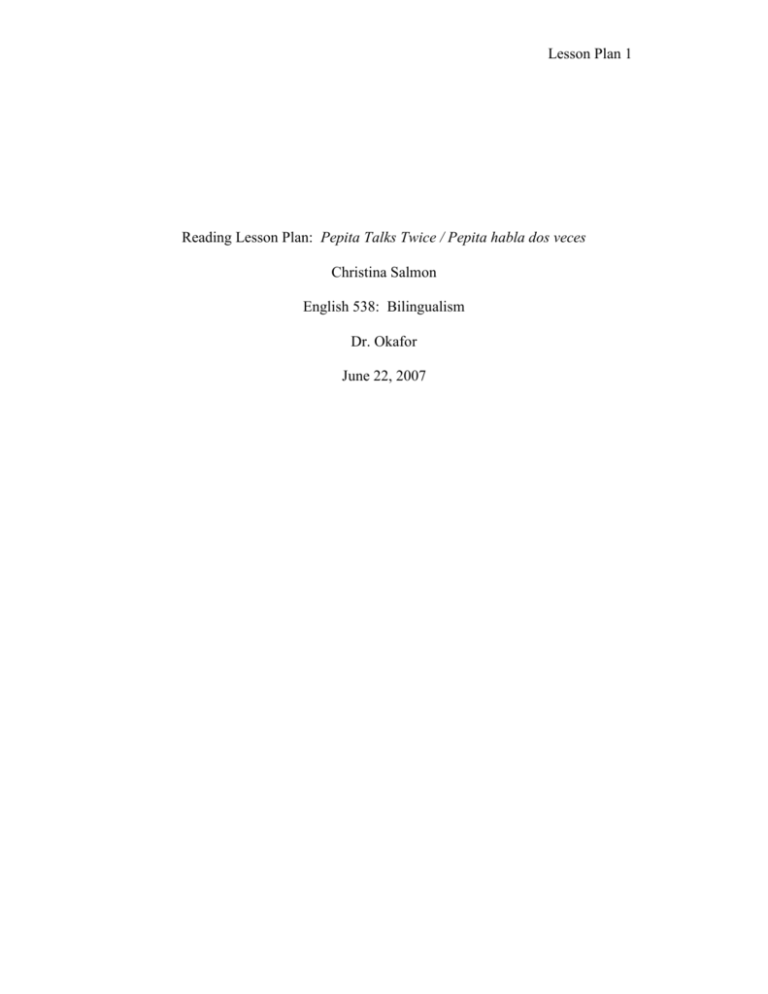
Lesson Plan 1 Reading Lesson Plan: Pepita Talks Twice / Pepita habla dos veces Christina Salmon English 538: Bilingualism Dr. Okafor June 22, 2007 Lesson Plan 2 Lesson Plan: Pepita Talks Twice / Pepita habla dos veces Grade 3 Proficiency Level: Beginning-Advanced Time: 90 minutes Maryland Content Standards: 3.A.3.b – Identify and explain the elements of a story. 3.A.8.a – Identify and explain the believability of the characters’ actions and the story’s events. TESOL Standards: Goal 1, Standard 1 – To use English to communicate in social settings: Students will use English to participate in social interactions. Goal 1, Standard 2 – To use English to communicate in social settings: Students will interact in, through, and with spoken and written English for personal expression and enjoyment. Objectives: Students will learn about Mexico. Students will compare life in Mexico with life in the United States for a child. Students will read and understand Pepita Talks Twice / Pepita habla dos veces. Students will identify the problem and solution of the story. Students will brainstorm alternate solutions to the problem. Students will identify pros and cons of each solution and judge the best one. Students will describe a problem they have had and explain how they solved it. Materials: Houghton Mifflin 2005 Reading Textbooks (includes the story, Pepita Talks Twice/Pepita habla dos veces by Ofelia Dumas Lachtman) Vocabulary flashcards Problem-solution graphic organizer Story summary sheet of Pepita Talks Twice/Pepita habla dos veces World map United Streaming video clip of “Children of Other Lands: Andres Orosco of Mexico” Procedures: 1. Display a map of Mexico and ask students to tell anything they know about the country. (If there are ESL students from Mexico, let them know ahead of time so they can think of ideas to share with their classmates.) 2. Show the twelve minute United Streaming video clip “Children of Other Lands: Andres Orosco of Mexico.” 3. After showing the clip, discuss similarities and differences between students in the class and 8-year-old Andres. Tell students that they will be reading a story about a girl from Mexico who now lives in the United States. Have students make inferences of what it would be like to move to a different country. Allow ELLs to share their own experiences. (Let them know ahead of time.) Lesson Plan 3 4. Have students take a picture walk of the story, Pepita Talks Twice. Ask students what they notice about the book. (The text is in English and Spanish.) Have students use the pictures to predict events of the story and problems Pepita will have to deal with. 5. Introduce the vocabulary for the story using the “Building Background” section of the reading textbook and student flashcards. 6. Put students into small groups (with teacher or assistant) to do a guided reading of the story. (Students reading below grade level or ESOL students may benefit from reading the condensed summary version of the story instead.) In groups, discuss other solutions Pepita could have tried to solve her problem. Model for students how to complete the first part of the problem-solution graphic organizer and have students decide good and bad points about Pepita’s actual decision. 7. In the whole group after reading, have students with a partner brainstorm another solution Pepita could have used to solve her problem of having to say things twice. Have them write their solution in the graphic organizer and identify good and bad points of that decision. 8. Have students complete this journal write: Tell about a problem you have had. How did you solve it? Were there any other ways you could have solved your problem? (ESOL: Allow beginning proficiency students to draw a picture of their problem, and how it was solved. Or, allow them to respond to one of these journal writes: Have you ever had a language problem like Pepita? How did you solve it? How do you feel when people ask you to “talk twice” like Pepita?) 9. Have students pair-share their journals. 10. Closure: Have students share their alternate solutions to Pepita’s problem with the whole class. Review the objectives of the lesson together. Assessment: Check problem-solution charts for understanding of the problem and solution of the story. Lesson Plan 4 Name ___________________________________________ Date ____________________________________________ Problem-Solution Graphic Organizer Pepita’s Problem: Solution Pepita’s Solution Good Points (Pros) Bad Points (Cons) Another Solution Another Solution Which solution do you think Pepita should have used? Explain why. ___________ Lesson Plan 5 The lesson plan for using the story Pepita Talks Twice was intended to make students interested in learning about another culture. Throughout the lesson, students will also learn about problem solving. This lesson also provides many opportunities for students to interact with the literature, and this multicultural story allows students to understand the point of view of a bilingual person. There are many benefits for using this lesson in a mainstream classroom with ELLs. The story of Pepita Talks Twice is about a young girl living in the United States who speaks both English and Spanish well. People in her neighborhood are always asking Pepita to translate for them, and she is getting tired of it. She decides to stop speaking Spanish altogether, even though her family communicates in Spanish at home. Over the course of a week, Pepita speaks only English, but she is not as happy as she thought she would be. By the end of the story, Pepita’s dog runs out into traffic. She calls out to him in English, but he doesn’t understand, and when she calls out to him in Spanish, she saves him from getting hit by a car. She realizes that having to “talk twice” may not be as bad as she thought it was, and she goes back to speaking both English and Spanish. One of the reasons I selected this story was because it is written in both English and Spanish. ELLs would gain a sense of pride from seeing a book used in their classroom that contains a language other than English. Also, beginning English speakers of a Hispanic background would be able to understand the same story as their classmates. Pepita Talks Twice is a high-interest story for children, and the illustrations also beautifully done. Many students are excited to attempt to speak the Spanish language contained in the story. Hispanic ELLs would be able to teach their classmates a bit of Spanish. Lesson Plan 6 The first aspect of the lesson is showing students a video clip of what life is like in Mexico for a child of their own age. This opens their eyes to another culture that they may have no knowledge about. It allows students to also understand the background of the main character, Pepita. If there are Mexican children in the class, their classmates will also gain an understanding of their backgrounds as well. These students may again feel pride in showing their native country to their new classmates. This activity will also build student interest and anticipation of the story. When students take picture walks, it allows them to formulate new ideas about the story. They are able to use reading strategies such as predicting and questioning before reading to aid in their comprehension. Learning new vocabulary helps students better understand the story as they read. Using flashcards is beneficial for kinesthetic learners as they practice new vocabulary. When reading the story, it is necessary for students to be in smaller groups with a teacher or assistant. The reading level is high third grade, so students reading below or beginning grade level may have difficulty comprehending the story. Novice ESOL students who do not speak Spanish and below-level readers may need the story to be summarized in order to better understand it. Fortunately, the Houghton Mifflin Reading series provides a one-page summary of each story for students who are reading below grade level. By reading the shorter version of the story, students are still able to participate in class discussions of the story with their classmates. This series also provides each story on a CD so that in the days following this lesson, students would be able to use the listening center and follow along with the story to build their comprehension. As long as students are accommodated when reading the story, then students will understand it and be able to complete the problem-solution skill lesson. Lesson Plan 7 When teaching students a new skill or concept, I always try to use the “I do, We do, You do” strategy. The teacher first models the skill, and then students have the opportunity to work with a partner or small group on the skill. Finally, students practice the skill independently. This lesson provides the “I do, we do” parts of this strategy. Students would have the opportunity in the following days to practice the problem-solution skill with partners or independently. This is an important skill for students to understand because it allows them to think about solutions to problems. By learning how to identify pros and cons of decisions, students are being provided with a life-long skill. However, ELLs may need more modeling from the teacher before understanding the skill and attempting it on their own. Allowing these students to draw a picture instead of writing a response would be a different way of sharing their knowledge. I try to include journaling often in lessons. Students should have the opportunity to express themselves and their ideas, and it allows them to make a personal connection to the text. By describing a problem they have had allows students to compare themselves to Pepita and better understand her situation. They can analyze the way they solved their problem as they did with Pepita’s problem. The modified journal write for ESOL students might allow for a stronger connection to the text for them. Having students share their journal with a classmate would offer another perspective for their problem, and allow them to understand that everyone has problems that can be solved in different ways. I believe that this lesson has many benefits for both mainstream and ESOL students. There are many activities that allow students to connect with the story and its characters. The reading lesson is tailored to meet the needs of students of different reading levels. The problemsolution skill teaches children how to solve problems by thinking about the pros and cons of a decision. Overall, this lesson would be very effective for all students in a third grade classroom.
